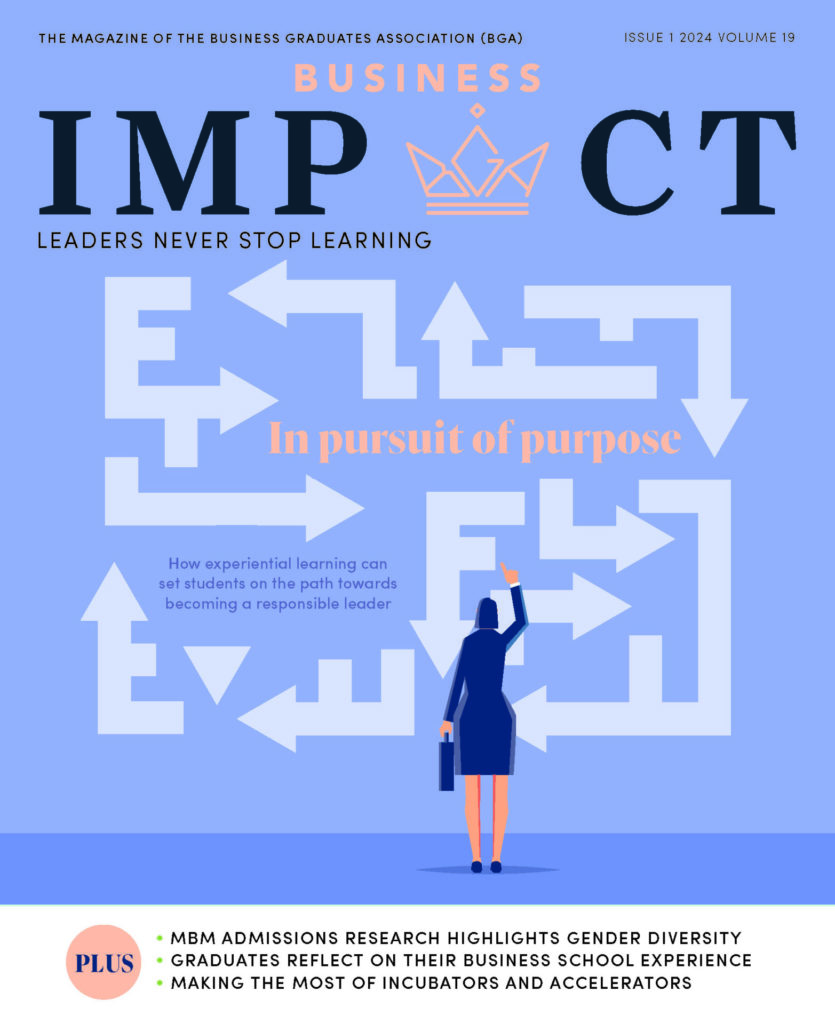In Deloitte’s 2020 Global Human Capital Trends report said: ‘Technology creates a sense that anything that can change, will; yet humans desire a sense of certainty to support bold steps forward.’ Two years on, this still rings true – especially for the education sector.
The global e-learning market is projected to be worth approximately $330 billion USD by 2026, with the UK’s share of the market expected to grow in value by $9.94 billion USD from 2020 to 2025. If it was not already apparent prior to the pandemic, technology has now certainly proven its potential to shift industries beyond realms once imagined, yet, despite the eagerness to do so, challenges remain ahead.
Society is becoming more and more reliant on technology and it is therefore incumbent on business school leaders to harness the power of digital technologies and create school cultures that are transparent, relevant, meaningful, engaging, and inspiring.
In addition, we need to consider how recent changes such as ubiquitous connectivity, open-source technology, mobile devices, and personalisation impact the growing globalisation of education that has come from developments in technology and remote learning.
Digital design and personalisation
Digital leadership is the strategic use of digital assets to achieve business goals. Organisations that place digital leadership at the forefront often place value on communication, creativity and a willingness to explore new ways that technology and digital information can be used to address operations successfully. With effective digital leadership, workflows and business processes remain streamlined, allowing those situated across various worldwide jurisdictions to receive the same service.
A big challenge that remains is ensuring that, on an international scale, educational opportunities are not only consistent but also meet the expectations and needs of students scattered across different countries. This will extend further than ensuring access to digital learning – it’s about awareness of the differences in how technology is used across various continents.
For digital learning to remain consistently effective, organisations need to pinpoint how students interact with technology. How do students engage with the platforms provided for them by their institution? Students at Arden University, for example, can communicate using Moodle-based forums, Zoom live sessions, or even Slack. But how do they use other technologies? Having been provided with Office365 subscriptions on enrolment, do they use email or WhatsApp to converse with peers? Do they have unspoken rules about interacting with each other and their lecturers in specific spaces? These variations may seem infinitesimal, but they vastly impact student engagement, learning and interaction, and our understanding of these.
Offering personalised learning depending on jurisdiction is no easy feat and, now that globalisation has pushed diversity and inclusion to the forefront, it’s vital for digital education to be a strong piece of the diversity puzzle.
Nearly half of students are using online learning platforms for homework assistance, with 70% of students agreeing that online classes are better than traditional classroom settings. Online learning and digital technologies have also opened doors for students with additional needs. Therefore, for all students to be considered, e-learning platforms must take into consideration neurodiversity and different learning needs.
An underlying issue remaining in the education sector is that educators may stick to using a particular approach when teaching, or there may be a tradition of teaching a particular subject area in a specific way. These methods of teaching, as well as how progress and achievements are assessed, could be a barrier for neurodivergent learners. For example, group working assignments can be a challenge for autistic people and people with ADHD, while written assessments can be a barrier for learners with dyslexia, dyspraxia or dysgraphia.
If traditional education systems become more inclusive of students with additional needs, they will become much more inclusive in general, and all education providers, employers, applicants and employees will benefit. This aspect is often tricky for some to navigate within the realm of e-learning, however. Empowering educators with knowledge and practice around digital pedagogies and technologies will enable them to be responsive to the evolving needs and expectations of students. At Arden University, for example, we are encouraging our staff to undertake a Postgraduate Certificate (PGCert) in Digital Pedagogies and Practices to help them do this.
One of the biggest opportunities technology offers, however, is developing digital learning in collaboration with students. In-house developers could create a few courses along with academics and modify them according to learner engagement and feedback. However, they can also work with groups of students to test and prototype new activities and content before these are released to a wider student cohort.
Universities are increasingly recognising that adopting personalised digital experiences means expanding their concept of what ‘personalised’ means. Rather than focusing purely on consideration of AI in digital education, meeting the requirements of personalisation means implementing the wide flexibility technology offers with regards to schedules, credit load, learning content, additional support and student engagement.
Blended e-learning requires study materials and related services to support online platforms. For example, this mix of learning at Arden University has meant implementing different types of assessment methods and steering away from traditional timed examinations.
Access to technology
One stubborn issue revolves around access to technology. For international education to become equal across the world, there needs to be better means for students in particular areas to access it. The prevalence of technology in education will hinder some parts of the world more than others, not just due to lack of funding, but also due to a lack of infrastructure and, in some parts of the world, the gatekeeping of technology for political and/or economic reasons.
Universities will need to think of ways to offer offline courses via digital technology, for example, for those who don’t have reliable internet access. Offline digital education is still digital, but it requires creativity in pedagogic approach and learning design.
After all, digitalisation and the application of emerging technologies have accelerated the demand for digital skills, and social inequalities affect individuals’ skills and proficiencies in this area. Universities and colleges have appealed for help in equipping young people with digital skills, admitting they lack the resources, knowledge and infrastructure to tackle the tech talent shortage on their own.
This shift is pushing universities to think differently and ensure that while digital education can promote the learning behind technology usage, it also brings teaching the correct, practical skills to the forefront. Studies have shown that students that spend more than 60 minutes per week on e-learning activities perform better, but we must still ask: ‘We can learn via an app, but will it provide the best learning experience for everyone?’
International learning
International students at universities are often in the traditional onshore delivery model – largely living and studying in person for the duration of their degree. These students also tend to come from the wealthiest segments of the source countries.
Digital learning, on the other hand, presents opportunities for institutions across the world to build out a broader set of delivery options and reach a massive group of people who may not be able to afford a full-time in-country experience. For example, Arden University now offers blended learning degrees in Pakistan, UAE and Berlin, and is moving towards offering full-time distance learning programmes that prioritises the international student experience.
India, for example, has set the ambition of training more than 400 million people by 2022 to meet its future workforce needs and Indonesia has a target of educating an additional 57 million skilled workers by 2030. Only a small fraction of these numbers would be able to access traditional international education.
However, it is important not to rely too heavily on technology to provide international students with the best-possible learning experience. For universities to meet this market with greater use of online delivery, hybrid learning models in both full course and microcredentials are vital to consider.
Despite disruption creating opportunities to rethink business models and look at possibilities for the future, longer-term difficulties will remain – some of which were apparent prior to the pandemic – in international digital leadership post-Covid-19. As digital leaders, we need to be creative and innovative now more than ever.








